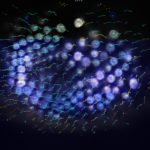Link to Pubmed [PMID] – 38240380
Link to HAL – pasteur-04779435
Link to DOI – 10.1242/dev.202144
Development 2024 Feb; 151(4):
Skeletal muscle stem cells (MuSCs) are recognised as functionally heterogeneous. Cranial MuSCs are reported to have greater proliferative and regenerative capacity when compared with those in the limb. A comprehensive understanding of the mechanisms underlying this functional heterogeneity is lacking. Here, we have used clonal analysis, live imaging and single cell transcriptomic analysis to identify crucial features that distinguish extraocular muscle (EOM) from limb muscle stem cell populations. A MyogeninntdTom reporter showed that the increased proliferation capacity of EOM MuSCs correlates with deferred differentiation and lower expression of the myogenic commitment gene Myod. Unexpectedly, EOM MuSCs activated in vitro expressed a large array of extracellular matrix components typical of mesenchymal non-muscle cells. Computational analysis underscored a distinct co-regulatory module, which is absent in limb MuSCs, as driver of these features. The EOM transcription factor network, with Foxc1 as key player, appears to be hardwired to EOM identity as it persists during growth, disease and in vitro after several passages. Our findings shed light on how high-performing MuSCs regulate myogenic commitment by remodelling their local environment and adopting properties not generally associated with myogenic cells.






